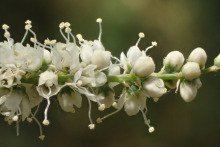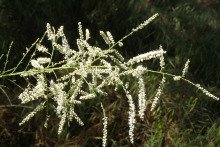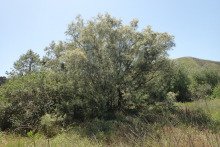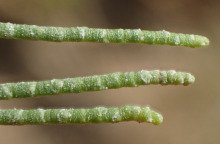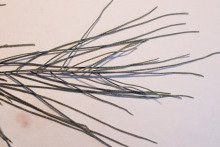The native range of T. aphylla extends over the Middle East, North, East and Central Africa, and parts of West and South Asia (Brandis, 1924; Bailey, 1960). The species is thought to have originated in the Central Sahara, from where it spread to Pakistan, India, Afghanistan, the Middle East, Egypt and North Africa, as well as to Eritrea, Somalia, Kenya and Ethiopia (National Academy of Sciences, 1980; Qaiser 1981).
In North America, it occurs south of the freeze zone in the southern parts of California, Arizona and Texas, or roughly south of the 34th parallel from California through New Mexico and below the 30th parallel in south Texas. It extends into northern Mexico approximately to the 24th parallel. Griffin et al. (1989) gives the distribution of T. aphylla in Australia.
T. aphylla is a large (to 20 m tall with a trunk to 1 m or more in diameter) evergreen tree to high shrub. It generally attains small height and large girth. A variable height of the tree has been reported in the literature; 8-12 m (National Academy of Sciences, 1980) and 18 m height and girth of 1.8-2.1 m, occasionally attaining 3-3.5 m girth (Troup, 1921; Brandis, 1924). The tree is not very long-lived. It tapers rapidly and is heavily branched, but its crown does not spread widely.
It has slender, cylindric, jointed branches which are articulate at the base of the sheath. The bark is reddish-brown to grey and the slender twigs are often hoary with deep punctate glands that produce a saline efflorescence. The salty 'tears' drip in the night and the soil beneath trees is generally covered with a salt layer (Troup, 1921; National Academy of Sciences, 1980).
The foliage is fine bluish-grey or greyish-blue and superficially resembles long pine needles or Casuarina foliage. The leaves are small (about 2 mm long) and reduced to tiny scales that ensheath the wiry twigs and are well equipped to withstand desiccation (Troup, 1921). The lamina is reduced to a minute triangular tooth that is marked with glands. The tree is never totally leafless.
The flowers are loosely arranged on the slender spikes. They are small, usually white, occasionally pink, unisexual or bisexual, monoecious or dioecious, sessile and delicate. They are scattered on long, slender spikes which are usually clustered at the end of branches in loose racemose panicles, bracts sheathing. Vernal inflorescences simple, aestival ones compound and more common. Raceme 3-6 cm long, 4-5 mm broad, with sub-sessile flowers. Bracts triangular to broadly triangular, acuminate, somewhat clasping, longer than pedicels. Pedicel much shorter than calyx. Calyx pentamerous. Sepals ca. 1.5 mm long, entire, obtuse, the two outer slightly smaller, broadly ovate to broadly elliptic, slightly keeled, the inner slightly larger, broadly elliptic to sub-orbicular. Corolla pentamerous, sub-persistent to caducous. Petals 2-2.25 mm long, elliptic-oblong to ovate-elliptic. Androecium haplostemonous, of five antesepalous stamens; filaments inserted between the lobes of the nectary disc (hololophic) (Baum, 1978).
Fruit is a small, bell-shaped sessile capsule, and ripens in the cold season. The capsules contain minute seeds with tufts of long, soft, woolly hairs. Ripe capsules turn brown and open up gradually to allow the minute seeds to be dispersed by the wind.
Tamarix aphylla has been used as a windbreak and shade tree in agriculture and horticulture for decades, especially in dryer regions such as the western United States and central and western Australia. Due to its higher fire adaptability it can be used as a barrier to fire. Even when dry, the wood of Tamarix is difficult to burn, due to the high ash content (30–40%) and higher salt content of its foliage. After a fire it usually regrows, unless the root-crown was destroyed. The nectar from the blossoms of tamarix aphylla produces a high-quality honey with a unique taste. Due to drought- and salt-tolerant properties of the tree, it could be planted as an agro-forestry species, as well as for reclamation of marginal lands. Vegetative propagation method for the tree using aeroponics technique has recently been developed.
Australia Within these regions it has spread, most dramatically and noticeably in central Australia after floods of 1974 along the Finke River in the Northern Territory. Since then it has become a serious weed and invasive species in the Northern Territory and Western Australia. The species had been present for many decades without much spread before this. It tends to use more water than most native plants in Australia, which it outcompetes. It has replaced the indigenous eucalyptus along watercourses in the interior. It has been declared a weed of national significance in Australia.
United States It is commonly used for windbreaks on the edges of agricultural fields and as a shade tree in the deserts of the Southwestern United States. This species has not naturalized in areas of the United States where it has been grown, unlike other species in the genus Tamarix that are vigorously invasive.
